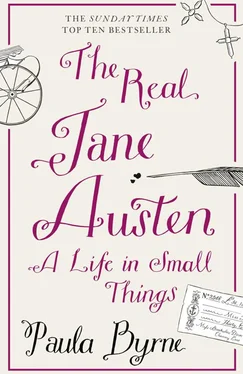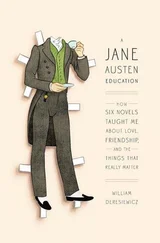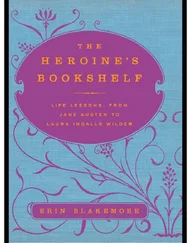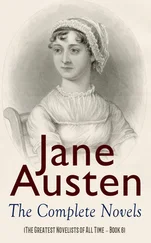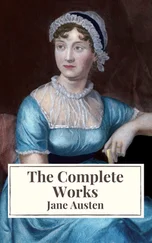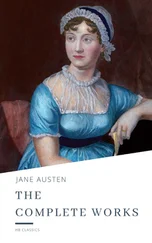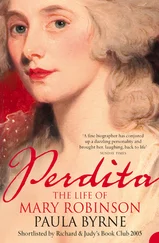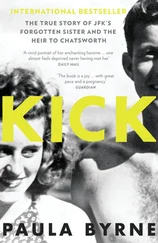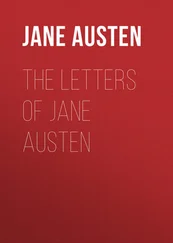Silhouettes were known as ‘shadows’ or ‘shades’ or ‘profiles’. Hence Austen’s imagining of the ‘collection of family profiles’ in Fanny Price’s sitting room in Mansfield Park. This one tells a story. To modern eyes, the starkly shaded medium seems particularly fitting because of the solemn nature of the subject: the handing over of a child from one family to another. It was commissioned by Thomas Knight, a wealthy but childless gentleman from the county of Kent, to commemorate his formal adoption of his nephew, Edward Austen, one of the elder brothers of the future novelist. It was not only the Wellings silhouette that commemorated the adoption. The Knights also had an oil painting commissioned. This painting hangs now in Chawton Cottage and shows a very handsome child with golden hair and bright hazel eyes. He is wearing a blue velvet suit.
In the family profile the father, to the left of the scene, is George Austen. The adoptive mother, receiving Edward, is Catherine Knight, who many years later became Jane Austen’s only literary patron. Thomas Knight himself is to the right, standing over his sister Jane. In 1783, the boy Edward reached his sixteenth birthday, whereas the child in the silhouette appears to be rather younger. This suggests that Knight may have requested the artist to evoke the scene two or three years earlier when the boy first went to stay with the childless couple in the great house.
Little Neddy first met his wealthy uncle and aunt when he was twelve. In 1779 the newly married Knights visited their relatives at Steventon and took such a fancy to the golden-haired boy that they decided to bring him along with them on their honeymoon. It was quite common to do such a thing: George and Cassandra Austen took a boy called George Hastings with them on their own honeymoon tour. Genteel children generally had more freedom and independence than we might expect by today’s standards: as a young girl, Jane Austen’s sister Cassandra often visited her aunt and uncle Cooper in Bath.
In 1781 Thomas Knight inherited two large estates in Hampshire and Kent. By then, it was a matter of concern that he and his wife Catherine showed no sign of having children of their own. They needed a suitable boy to adopt and make their heir. Again, the practice was not unusual in the Georgian era, when the preservation of large estates was the key to wealth and status. So it was that young Edward Austen was taken away to Kent, first for extended visits during the summer months and eventually as a permanent arrangement. According to perhaps over-dramatic family tradition, George Austen hesitated, only for his wife to say, ‘I think, my Dear, you had better oblige your cousins and let the Child go.’ Mr Knight’s coachman, who had come on horseback, had led a pony all the way from Godmersham in Kent. The boy rode it all the way back, about a hundred miles. Among the brothers and sisters he said goodbye to when he left home was Jane Austen, aged about five and a half.
It wasn’t just boys who were transferred into wealthy families. Jane Austen knew at least two childless couples who adopted young girls and made them their heirs. There was Lord Mansfield, the great abolitionist judge, who adopted his niece Lady Elizabeth Murray. She became a neighbour of Edward Austen, and met Jane Austen on several occasions. And then there was a family called the Chutes in a big house near by, who adopted a girl called Caroline Wigget when she was three years old. So it should not come as a surprise that Jane Austen’s novels show more than a passing interest in adoption. In Mansfield Park Fanny Price, considered a burden on her family, is sent to live with her wealthy cousins, the Bertrams. In Emma, Frank Churchill is adopted into the family of a rich but childless couple, and Jane Fairfax, an orphan, is brought up with the Dixons.
The case of Emma Watson in Jane Austen’s incomplete novel The Watsons offers a striking reversal of the convention, whereby she has lived away from her birth family but is sent back to live with them. In Emma, Isabella Knightley exclaims against adoption, suggesting that it is unnatural: ‘there is something so shocking in a child’s being taken away from his parents and natural home! … To give up one’s child! I really never could think well of any body who proposed such a thing to any body else.’2 But Jane Austen believed that the good fortune of one family member was the good fortune of all.
***
On a fine summer’s day in 1782 a six-year-old girl was excitedly awaiting the return of her father in a hack chaise, the equivalent of a taxi cab, from the main stage-coach post in Andover, Hampshire. Her father was returning home with his elder daughter, who had been visiting relatives in Bath. Unable to contain her excitement at seeing her beloved sister, and with the promise of a ride home in the chaise, the six-year-old dragged her three-year-old brother Charles by the hand and they walked alone as far as New Down, a hamlet near Micheldever – some six miles away – to meet the chaise.3
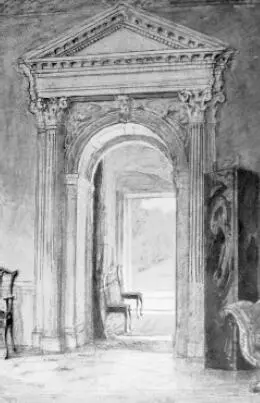
The entrance hall of the big house at Godmersham, where Edward Austen lived on being adopted by his wealthy uncle
Jane Austen, the seventh child of the Reverend George Austen and his wife Cassandra, née Leigh, was born in the Steventon village rectory on Saturday 16 December 1775, and baptized privately by her father on the morrow to ensure that her soul would be saved should she die in her first few days. He said that she looked very like her brother Henry, who was four, and would be ‘a plaything’ for her sister Cassandra, who was nearly three.4 Jane was publicly christened the following April, on Good Friday. She had three godparents: her great-aunt, also called Jane Austen, wife of Francis Austen of Sevenoaks in Kent, a well-to-do relative; Samuel Cooke, a vicar from Surrey who had graduated from Oxford and was related to a maternal cousin; and a Mrs Musgrave from Oxfordshire, wife of another maternal cousin.
These are the bare facts of her birth, but the walk to meet the hack chaise is the first glimpse we have of her as a child. The vignette may suggest that she was bold and unafraid to take the lead. What it certainly indicates is how much she loved and missed her elder sister. It sets a pattern for the rest of her days. For most of her life, Jane Austen was under the same roof as Cassandra. When they were parted, with one of them visiting friends or relations, they wrote to each other almost daily. Infuriatingly, Cassandra’s letters to Jane are lost and, to our eyes unforgivably, Cassandra destroyed far more of Jane’s than she kept. But those which survive provide the best record we have of her inner life.
Jane Austen was brought up in a large and loving family, consisting mainly of boys. She was one of two girls in a family of eight, sandwiched between Frank, who was born in 1774, and the youngest, Charles, born 1779. These two would grow up to become her ‘sailor brothers’. Frank was just twenty months older than Jane. Charles she described, quoting one of her favourite writers, Fanny Burney, as ‘our own particular little brother’.5 Her brothers were of immense importance to her throughout her life. The loss of nearly all her letters to them leaves the biggest gap in our knowledge of her. She wrote to Cassandra only when they were apart; she wrote to her brothers away on service almost all the time.
All the Austen children were nursed with a neighbouring family, the Littleworths, returning home when they were toddlers. One of them gave the family particular anxiety: George, the second son, born in 1766, was mentally incapacitated. He was epileptic and possibly deaf. In July 1770, his father wrote that the little boy was suffering from fits and showed no sign of improvement: ‘God knows only how far it will come to pass, but for the best judgment I can form at present, we must not be too sanguine on this Head; be it as it may, we have this comfort, he cannot be a bad or a wicked child.’6
Читать дальше
